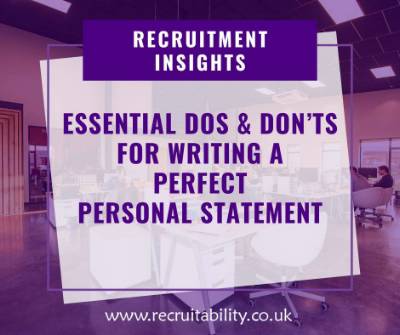Call us on: 01279 758855
Call us on: 01279 758855

In the competitive realm of job applications, a personal statement can be your golden ticket to capturing the attention of potential employers. Unlike a cover letter, which addresses your suitability for a role in a more broad context, a personal statement is an opportunity to highlight your unique qualities, experiences, and ambitions in a more personal, detailed manner. It has the power to turn a generic application into an unforgettable narrative. This blog post will elucidate the dos and don'ts of creating a compelling personal statement that will complement your CV and amplify your chances of landing that dream job. What is the Purpose of a Personal Statement? A personal statement serves as a self-marketing tool that goes beyond the constraints of a CV’s formal structure. While a cover letter introduces you and your qualifications to the employer, a personal statement delves deeper into your character, giving employers a peek into who you are beyond the professional facade. Furthermore, employers utilise personal statements in their selection process as a method of distinguishing between candidates with similar qualifications but differing career outlooks and professional ethos. Within your statement lies the chance to showcase how your goals align with the company's vision. Preparing to Write Your Personal Statement Prior to putting pen to paper, it is imperative to conduct thorough research into the company’s culture and the specifics of the job role. Having a profound understanding of the organisation’s values and the requirements of the position will allow you to tailor your personal statement accordingly. Identify your key skills and experiences that resonate most with the job description, and don't hesitate to reflect on your personal achievements that demonstrate your suitableness for the role — remember, this is a chance to sell your strengths and personal attributes. The Dos of Writing a Personal Statement A. Clarity and Conciseness If your CV is one of many, the recruiter will have limited time to review it. Ensure that it is clear and concise. Your statement should be succinct, stripped of unnecessary jargon and complex syntax that may obscure your message. B. Tailoring to the Job Customise your personal statement to reflect the job advert. Echo the language of the job description and pepper in keywords that align with the company’s expressed needs. C. Highlighting Achievements Incorporate specific examples of past successes into your statement, and where feasible, quantify these achievements. This concrete evidence of your capabilities can set you apart from the competition. D. Showing Passion and Enthusiasm Express a genuine enthusiasm for the role and the company. Convey not just your knowledge of the industry, but also your eagerness to contribute to it within the company’s framework. E. Structure and Flow Your personal statement should be well-structured, with a clear beginning, middle, and end. A coherent narrative will guide the employer through your professional journey effectively. F. Proofreading Do not underestimate the power of a well-edited document; thorough proofreading can prevent undermining your professionalism with simple errors. Additionally, seeking external feedback can provide valuable insights. The Don'ts of Writing a Personal Statement A. Avoiding Clichés and Overused Phrases Steer clear of trite phrases and strive to present your story in an original and engaging way. Avoid clichés that do little to differentiate you from the crowd. B. Being Vague or Generic Generalisations and vague expressions weaken the impact of your statement. Instead, back up your assertions with specific examples and evidence. C. Including Irrelevant Information Every sentence should serve a purpose. Irrelevant personal details or anecdotes that do not bolster your application should be omitted. D. Lying or Exaggerating Honesty is the best policy. Fabrications in your personal statement not only carry the risk of being uncovered but also can jeopardise your professional reputation. E. Neglecting the Visual Format The visual format of your personal statement should never be neglected. An appropriate font, layout, and a clean design ensure readability. F. Overlooking the Closing Conclude your personal statement with a decisive and memorable ending that reaffirms your keen interest in the role and your suitability for it. Additional Tips for a Standout Personal Statement Utilise an active voice to convey a sense of immediacy and engagement. Inject your personality into the statement while remaining professional and avoid dwelling on employment gaps or career changes unless they can be framed positively. Tailor each statement to the specific role and company, rather than adopting a one-size-fits-all approach. Beware of resting on your laurels – frequent updates to your statement are necessary to keep pace with your evolving professional experiences. Common Mistakes to Avoid Duplicating information that can easily be found on your CV can disengage readers, while using excessive technical jargon or acronyms without explanation can confuse them. And finally, never submit your application without reviewing your statement multiple times. The crafting of a perfect personal statement is a balance of well-selected content, appropriate style, and personal touch. Allocate the necessary time to develop a persuasive and honest statement that reflects who you are and what you can offer to a potential employer. Remember, authenticity and meticulous attention to detail can transform your job application from ordinary to captivating. Should you need more personalised advice or consultation services, contact RecruitAbility today on 01279 758855.
Posted on Wednesday Jun 26
|